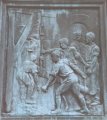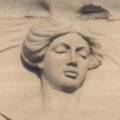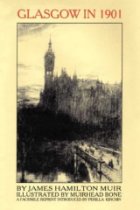 |
|
| Newsletter No.5 | 30 May, 2002 |
|
Welcome to our May Newsletter:
|
|
Most of the additions to our web-site this month have been new image galleries of the works of William Kellock Brown (1856-1934).
This month's "Inside Story" deals with the loss and vandalism of more of Glasgow's precious sculptural heritage. Last month's article on Walter Macfarlane's Saracen Foundry | generated quite a few emails plus photographs of a horse-trough and lamp in Mowbray, Cape Town, South Africa. Please keep letting us know of any new "finds" out there in the world beyond Glasgow.
Thanks again for visiting us and do send us an email if you would like to comment on our website or if you have anything to add to our research. And please don't forget to let all your friends know. See you on the website! Tim Gardner
| top |
|
New photo galleries during May:
|
 Statue of Donald Dewar.
Statue of Donald Dewar.
Sculptor: Kenny Mackay (b. 1966)
| top |
 MacFarlane's Works Outside Glasgow.
MacFarlane's Works Outside Glasgow.
This is a new gallery which follows on from last month's article on Macfarlane's Saracen Foundry. The first pictures come from Mowbray in Cape Town, South Africa. We invite contributions for this gallery from anywhere in the world. | top |
 Monuments by William Kellock Brown.
Monuments by William Kellock Brown.
This gallery shows a selection of monuments and memorials in various locations around Glasgow. The image is from the Monument to David Younger, which can be found in Cathcart Cemetry. | top |
 Athenaeum Theatre.
Athenaeum Theatre.
Sculptor: William Kellock Brown (1856-1934)
| top |
 Castle Chambers.
Castle Chambers.
Sculptor: William Kellock Brown (1856-1934)
| top |

 |
The sculpture schemes on the following five Glasgow libraries were all by William Kellock Brown (1856-1934)
The architect was James Robert Rhind (1854-1918).
|
top |
|
New biographies during May:
|
| James Linburn Cowan (c. 1821- c. 1907). A Glasgow architect about whom little is known and of whose work little has survived. One of his most interesting buildings is at 98-100 West Regent Street, which he designed for the Masonic Halls Company as Lodge St John, Glasgow 3 bis. | top |
| Walter R Watson (c. 1873-1932). A Glasgow architect, he was a partner of J L Cowan in the early 1900s, as Cowan & Watson. | top |
| William York (1799-1865). One of Glasgow's most successful builders in the mid-19th Century. One of his most important buildings is the Custom House, Clyde Street (1838-9). | top |
| Samuel Park (fl. 1856-9). Just a note to let you know who this monumental sculptor was. | top |
| William Kellock Brown (1856-1934). This isn't a new biography of the very prolific sculptor, but we have added an almost complete list of his works in Glasgow, together with links to the galleries. | top |
|
Glasgow News:
|
|
Donald Dewar, the father of the nation, was honoured on 7th May with a statue at the top of Buchanan Street, in front of the Royal Concert Hall. The 9ft tall bronze statue was unveiled by the Prime Minister, Tony Blair. Donald Dewar, Scotland's very first First Minister, died on 11th October 2000.
Gary Nisbet's Lunchtime Lectures at Hutchesons' Hall are finding a very appreciative audience. There are still three lectures to be delivered in the series, the next being on 11th June, so, if you are in Glasgow, take the opportunity to go along and listen to Gary's unique story of Glasgow's sculpture. On 21st May the Queen officially opened the redeveloped Queen's Gallery at Buckingham Palace. This includes a major sculptural programme by Sandy Stoddart. High on either side of the hall run two friezes by Stoddart, the largest element of the commission. These are flanked by four relief panels. For the end of the hall, framing the entrance to the exhibition areas, Stoddart produced two free-standing figures. As part of the commission, the artist also created a life-size bust of the young Queen at the time of her coronation in 1953. The progress of this work was documented in a television programme, Artworks Scotland, shown on BBC2 on 25th May. David Mach's new exhibition at the Gallery of Modern Art is still on. You have until September 29th to get along there. I've been twice and intend seeing it at least another couple of times. You can see more of David Mach's work on his own website at http://www.davidmach.com. | top |
|
Inside Story:
Cone Heads
Had the city authorities and police given serious thought to the accessibility and damage to the Wellington Monument and the fact that this is much taller than the Dewar statue, together with the ‘coning’ of the even taller, fenced-in, Roberts and Kelvin Memorials in Kelvingrove Park, they would have seen that a monument’s height and its railings are no deterrent to anyone fuelled with alcohol and armed with a traffic cone. Rather than wasting money on these already tried, tested and failed security measures, a more effective solution would surely be for the Lord Provost and Glasgow’s most popular newspaper to publicly denounce ‘coning’ for the vandalism that it is rather than the non-malicious, high spirits that they have hitherto excused it as. Demolished!
In what must be regarded as ‘official’ acts of vandalism, the Broomielaw, which once teemed with the crews of ships from all over the world when the area was Glasgow’s docklands, has been stripped of two of its few remaining historic buildings. Both of which featured fine sculpture. The McAlpine Street Police Station was built in 1882, to an Italian Palazzo design by John Carrick, the City Architect. As well as being one of his last remaining district police offices, the building was distinguished by its fine carverwork which included a massive, Roman fasces (bundle of rods and an axe), a sword and a finely detailed city escutcheon which retained its original polychrome paint.
Also lost were escutcheons recording the institute’s founding in 1822, its construction in 1927, and the badges of two of the great shipping lines which had ships built on the Clyde and which made use of the institute's facilities, the famous White Star and Anchor Lines. Despite their historic, architectural and sculptural importance to the city and its maritime heritage, both buildings were demolished without outcry or comment. It is also of interest to note that both buildings stood in the Anderston district, which is represented in the City Council by our own Lord Provost, Alex Mosson! Author: Gary Nisbet | top |
|
Book Choice:
|
|
Glasgow in 1901
About the Author:
Published by White Cockade Publishing
Buy this book from... | top |
|
Don't forget to use the [F11] key:
|
|
When browsing our website you may find that you need more room to view the photo-galleries. That is where the [F11] key comes in. Press this key and you will get a full screen with just a narrow tool-bar at the top. If you liked that then right-click on the narrow tool-bar and select Auto-Hide. This will hide the tool-bar itself whenever you are not using it. Just slide the mouse-pointer towards the top of the screen and it will appear again. Press the [F11] key again to return to normal.
Unfortunately, this only works for MS Internet Explorer browsers. | top |
|
Recommend us to a friend:
|
| Please forward this newsletter on to any of your friends or colleagues who you feel may be even remotely interested in Glasgow or Sculpture. Even if they aren't now, I'm sure they soon will be. | top |
|
Unsubscribe or change email address.
Also for friends to confirm their subscription:
|
|
If you are one of the lucky ones that have been sent a complimentary copy of this Newsletter from one of your friends, please send a blank email to confirm and your subscription will be continued (just click on the underlined email address). No need to type anything. We will get your email address automatically.
If you wish to change the email address we send your Newsletter to, then please send an email to changeaddress, not forgetting to put your new address in the message field (just click on the underlined email address). If you would like to cancel your subscription completely, please send a blank email to cancel (just click on the underlined email address). In any case please be assured that we never pass on email addresses to any third party for any reason whatsoever. If you cancel an email address with us, then that address will be permanently removed from all our files. | top |
|
Contact us.
|
|
Email for general enquiries and information.
Email Tim Gardner, the editor and webmaster. Email Gary Nisbet, the historian. | top |
| Copyright 2002 scot-it.com | top |
 Kellock Brown collaborated with the architect James Robert Rhind to produce the sculpture schemes on seven of Glasgow's libraries.
Kellock Brown collaborated with the architect James Robert Rhind to produce the sculpture schemes on seven of Glasgow's libraries.
 The placing of traffic cones on the heads of Glasgow’s public statues has become something of a cult in recent years, with the Duke of Wellington and his horse, outside the Gallery of Modern Art, being regularly targeted. The city’s Lord Provost, Alex Mosson, and the press have until recently laughed this practice off as a typical piece of Glasgow humour; nothing more than a tribute to the recipient and a time-honoured tradition, a gentler version of the Glasgow Kiss and, in the case of the Evening Times newspaper and the Duke of Wellington statue, the source of a successful advertising campaign. So effective have these positive messages been upon those who get a kick from such displays of bravado, that a number of other Glasgow statues have also received the traffic cone treatment.
The placing of traffic cones on the heads of Glasgow’s public statues has become something of a cult in recent years, with the Duke of Wellington and his horse, outside the Gallery of Modern Art, being regularly targeted. The city’s Lord Provost, Alex Mosson, and the press have until recently laughed this practice off as a typical piece of Glasgow humour; nothing more than a tribute to the recipient and a time-honoured tradition, a gentler version of the Glasgow Kiss and, in the case of the Evening Times newspaper and the Duke of Wellington statue, the source of a successful advertising campaign. So effective have these positive messages been upon those who get a kick from such displays of bravado, that a number of other Glasgow statues have also received the traffic cone treatment.
 Now that Donald Dewar’s statue has been damaged as the result of a similar ‘tribute’, the practice has become an embarrassment to the city and proposals have been announced to heighten the pedestal in an effort to elevate Dewar’s head and vulnerable spectacles out of reach, and to erect a railing around it. In a typical case of locking the stable door after the horse has bolted, this is a solution to a problem which should have been foreseen during the monument’s design and siting process, and one which has already been proven to be less than effective in protecting other targeted monuments in the city.
Now that Donald Dewar’s statue has been damaged as the result of a similar ‘tribute’, the practice has become an embarrassment to the city and proposals have been announced to heighten the pedestal in an effort to elevate Dewar’s head and vulnerable spectacles out of reach, and to erect a railing around it. In a typical case of locking the stable door after the horse has bolted, this is a solution to a problem which should have been foreseen during the monument’s design and siting process, and one which has already been proven to be less than effective in protecting other targeted monuments in the city.
 Whilst all eyes have been focused on the unveiling of the Dewar statue and universal disgust has been expressed at its recent vandalism, few have taken any notice of the demolition of the Glasgow Seamen's Institute and the Marine Police Office in the Broomielaw which occurred in March.
Whilst all eyes have been focused on the unveiling of the Dewar statue and universal disgust has been expressed at its recent vandalism, few have taken any notice of the demolition of the Glasgow Seamen's Institute and the Marine Police Office in the Broomielaw which occurred in March.
 The greater loss of the two was the Seamen's Institute. Built in 1927, by R A Bryden & Robertson, this prominent, domed building incorporated reliefs of a sailing ship in full sail and a magnificent (and rare), Art Deco Ocean Liner amongst its sculpture, which recalled the institute’s service to seafarers in the area for well over a century (the institute’s chapel in Brown Street, by John Burnet (1861), which featured a statue of Hope Leaning On An Anchor by John Crawford, was demolished in the 1970s - for detailed descriptions and illustrations of both buildings see: Ray McKenzie’s Public Sculpture Of Glasgow (2002), pp. 29, 433, and the Virtual Mitchell Website, Brown Street, C2085).
The greater loss of the two was the Seamen's Institute. Built in 1927, by R A Bryden & Robertson, this prominent, domed building incorporated reliefs of a sailing ship in full sail and a magnificent (and rare), Art Deco Ocean Liner amongst its sculpture, which recalled the institute’s service to seafarers in the area for well over a century (the institute’s chapel in Brown Street, by John Burnet (1861), which featured a statue of Hope Leaning On An Anchor by John Crawford, was demolished in the 1970s - for detailed descriptions and illustrations of both buildings see: Ray McKenzie’s Public Sculpture Of Glasgow (2002), pp. 29, 433, and the Virtual Mitchell Website, Brown Street, C2085).
 Celebrating Glasgow at its height, at the dawn of the 20th century, this idiosyncratic and entertaining book vividly evokes a smoke-hazed and somber city, ringing and thundering with shipbuilding and other industries. Not beautiful, but alive and splendid. The young authors write with humor and passion. From the colorful backdrops of the quays, to the exhausted workers, to the ever-active "city man", the pages are alive with Glasgow scenes and types. The book is liberally illustrated by the pen drawings of Muirhead Bone. An introduction by Perilla Kinchin presents new material on the authors and briefly traces the city's changes in the last century.
Celebrating Glasgow at its height, at the dawn of the 20th century, this idiosyncratic and entertaining book vividly evokes a smoke-hazed and somber city, ringing and thundering with shipbuilding and other industries. Not beautiful, but alive and splendid. The young authors write with humor and passion. From the colorful backdrops of the quays, to the exhausted workers, to the ever-active "city man", the pages are alive with Glasgow scenes and types. The book is liberally illustrated by the pen drawings of Muirhead Bone. An introduction by Perilla Kinchin presents new material on the authors and briefly traces the city's changes in the last century.

